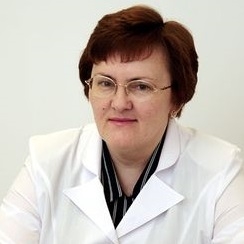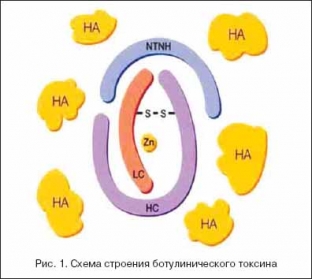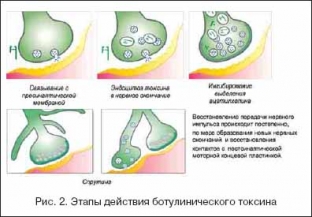"Mysterious molecule of the century" - such an epithet botulinum toxin deserved from the world neurological community in 2000 - exactly a thousand years since the beginning of the fight against it, and in recent years - in connection with its effective use to treat patients with a variety of diseases .

Olga Ratmirovna Orlova - neurologist, Doctor of Medical Sciences, Professor of the Department of Nervous Diseases of the First Moscow State Medical University. THEM. Sechenov and the Department of Plastic and Reconstructive Surgery, Cosmetology and Cellular Technologies of the Russian National Research Medical University, President of the Interregional Public Organization of Botulinum Therapy Specialists (MOOSBT)
Background and mechanism of action of botulinum toxin
Botulism is a serious infectious disease
Clostridium botulinum is an anaerobic bacterium that produces heat-resistant spores that germinate to produce a toxin called botulinum toxin. Botulism is a severe infectious disease manifested by peripheral muscle paralysis and autonomic disorders due to impaired peripheral cholinergic mediation caused by botulinum neurotoxin. The name "botulism" or "sausage poisoning" comes from the Latin word botulus, which means "black (blood) sausage".
There are currently 8 known serological subtypes of botulinum toxin: A, B, C1, C2, D, E, F, G. Botulism in humans can be caused by serotypes A, B, E, F, G, but the most potent type is A. Both in its natural form and in dosage forms, botulinum toxin is a mixture of various proteins. Their main components are neurotoxin (the biologically active component of botulinum toxin) and non-toxic proteins that stabilize the neurotoxin molecule (Fig. 1). The amino acid composition of type A neurotoxin has been deciphered, the light chain contains 448 amino acids, and the heavy chain contains 848. Other serotypes of botulinum toxin (from B to G) differ in the number and sequence of amino acids, mainly in the light chain.

The mechanism of action of all types of botulinum toxins.
The principal mechanism of action of all types of botulinum toxins is the presynaptic blockade of transport proteins that ensure the transport of acetylcholine vesicles through the calcium channels of the nerve terminal of the peripheral cholinergic synapse, followed by the release of acetylcholine into the synaptic cleft. Acetylcholine is a mediator in the synapses of the parasympathetic nervous system, some synapses of the central nervous system, in somatic motor and preganglionic sympathetic nerve endings. Cholinergic receptors are found in skeletal and smooth muscles, internal organs, sympathetic and parasympathetic ganglia. A special type of cholinergic receptors are H-cholinergic receptors of afferent endings located in the autonomic ganglia, where they, in essence, are sensory fiber receptors.
With intramuscular injection of botulinum toxin, 2 effects develop: direct inhibition of a-motoneurons at the level of the neuromuscular junction and inhibition of the g-motoneuron cholinergic synapse at the intrafusal fiber. Clinically, this is manifested in a pronounced relaxation of the injected muscles and a significant reduction in pain in them. With intradermal injection, blockade of postganglionic sympathetic nerves develops for 6-8 months and sweating stops.
When administered locally in therapeutic doses, botulinum toxin does not penetrate the blood-brain barrier and does not cause significant systemic effects.
There appears to be minimal presynaptic uptake and reverse axonal transport from the injection site, which may be the basis for the manifestation of distant effects of the drug. The process of presynaptic cleavage of transport proteins by botulinum toxin is irreversible and takes an average of 30-60 minutes, so specific botulinum antitoxin is effective only within an hour after the toxin reaches the target organs.
Despite the fact that the cellular effects develop very quickly and irreversibly, the clinical muscle relaxant effect of the drug after the injection begins to appear after a few days: in the small muscles of the face, larynx, hand - after 2-7 days, in the large muscles of the neck, extremities and trunk - after 7-14 days, in the skin and exocrine glands - after 1-5 days. However, there are observations of both an instant onset of the effect and a delayed effect for 3–4 weeks. 1–2 months after the injection, the process of regrowth of new nerve terminals from axons begins, where acetylcholine transport was previously blocked, with the formation of new functionally active neuromuscular synapses (the so-called sprouting), which ultimately leads to the restoration of muscle contractions after 3– 6 months after injection,

Botulinum toxin type A (BTA) blocks SNAP-25, the most active transport protein. All peripheral synaptic transmission in the body is carried out with the participation of transport proteins, therefore, botulinum toxin is able to affect wherever transport proteins work - in muscle tissue, in exocrine glands, in pain receptors.
Accordingly, the clinical scope of botulinum toxin (Dysport, Botox) can include 4 groups of different syndromes:
1 - hyperactivity of striated muscles (strabismus, hemifacial spasm, blepharospasm, spastic torticollis and other focal dystonia, spasticity, cerebral palsy, rigidity, hyperfunctional mimic wrinkles, tremors, tics, etc.);
2 - muscle hyperactivity sphincters (achalasia of the cardia, urinary disorders - detrusor-sphincter dyssynergia, spastic constipation, hemorrhoids and rectal fissures, vaginismus);
3 - hyperfunction of exocrine glands (hyperhidrosis, hypersalivation, lacrimation);
4 - pain syndromes (myofascial and muscular-tonic syndromes, tension headache, migraine, facial pain).
It was found that more persistent and complete effects of the toxin are manifested with maximum muscle contraction, with a sufficient intracellular concentration of calcium ions (and, possibly, potassium), when exposed to low temperatures. Therefore, during preparation for a therapeutic injection (2 weeks in advance), the patient is recommended to prescribe calcium and potassium supplements with vitamin D, immediately before the injection and immediately after it - to cool the injection area, and also to intensively strain the injected muscles for 15-30 minutes after procedures.
Physiological and clinical effects of botulinum toxin A
To date, evidence has accumulated that the effects of BTA in the treatment of focal dystonia and other neurological disorders are much more complex and broader than a temporary local block of conduction in the terminals of a-motoneurons. There appears to be blockade of both intrafusal and extrafusal fibers, which may explain the wider area of action of the drug after local administration. The effect of the toxin on the terminals of sensitive fibers of various modalities is also assumed. In particular, this may explain the rapid analgesic effect of BTA injection. Due to the mechanism of deafferentation of muscle spindle receptors and other types of sensitive systems, BTA can have indirect effects on the overlying parts of the CNS. When studying the motor potential, a decrease in the latent periods of its components was revealed,
The central mechanisms of action of BTA have been studied in the treatment of patients with cranial dystonia (CD) and cervical dystonia (CD). In 25% of cases, a distant effect was found: after injection of the drug into the muscles of one area in patients with multifocal dystonia, a decrease in dystonic disorders in other areas was observed. This effect cannot be explained by the diffusion of the drug into adjacent muscle groups, since the action could be manifested in a decrease in dystonia in distant muscles (for example, a decrease in the manifestations of writing spasm in the treatment of CD and CD). In the study of evoked abdominal reflexes, a significant decrease in interneuronal hyperactivity, characteristic of dystonia, was shown, although not reaching normal levels after the first injection. A decrease in the excitability of spinal interneurons may indicate the effect of BTA on the neuronal systems of the CNS through a decrease in the afferent flow to the spinal cord. Such an indirect effect of botulinum toxin on stem and spinal interneurons may be one of the most likely explanations for the distant effects observed in therapeutic practice. It is clear that the mechanism of action of botulinum toxin is wider than just a local muscle relaxant effect. Clinical remissions during dystonia, often caused by injections of the drug, may also be due to the fact that the deafferentation of muscle spindle receptors caused by this drug can lead to a rearrangement in the neurodynamic substrate of dystonia. This allows us to consider BTA as a means of not only symptomatic, but also pathogenetic treatment of dystonia.
During a conversation with the patient and / or his relatives, it is necessary to explain the mechanism of action and the effect of the drug on the main symptoms of the disease. It is very important to set realistic goals for the planned injection, which can be different for each nosological form: reduction of spasm and pain, increase in range of motion, improvement in quality of life, expansion of social activity, self-service, aesthetic effect, etc.One should not support the illusory dream of a “magic” cure after a single injection of an expensive drug. On the contrary, in cases where repeated injections are necessary (and this is the majority of cases), this issue should be discussed with the patient in advance. It is important to warn about the expected (predicted) temporary side effects, which are associated not so much with the procedure itself, but with the peculiarities of the drug's action in one or another nosological form. Then, if side effects occur, the patient will tolerate them more easily.
Importance of patient care when using botulinum toxin injections
Before treatment, the patient should read the informed consent protocol and complete it, discussing the ambiguities with the attending physician. This necessary ethical procedure provides additional guarantees for the success of the treatment. When possible, a video or photograph of the patient's initial state should be taken and then repeated in a dynamic post-injection examination. This is a documentary evidence of the effectiveness of treatment, especially important for those patients who underestimate its results. In addition, the analysis of video recordings helps to plan the selection of the patient's muscles for subsequent injections.
The room in which the injection is performed should be well lit, warm, spacious, so that you can examine the patient in full growth, undressed, and assess the nature of motor functions in the process of walking. It is desirable that the patient or his relatives observe the process of preparing the drug solution and dosing it in a syringe. Patients should be encouraged to discuss their treatment plan with their doctor, and even the choice of muscles to inject. As a rule, anesthesia for intramuscular injections is not required even for children. Superficial anesthesia with lidocaine spray or EMLA gel is performed before intradermal administration of the drug in the treatment of hyperhidrosis.
Primary failure is extremely rare, less than 0.1% after the first injection. It is always very difficult to make a conclusion about primary drug resistance, since there are no objective methods that absolutely confirm the fact of drug insensitivity. If a second injection (2 months after the first one) at the same dose and at the same points does not have an effect (objectively and subjectively), it is possible to conclude with a high probability of primary resistance.
Injections of botulinum toxin preparations for the temporary elimination of facial expression lines are currently a very common aesthetic procedure. However, despite the simplicity and obviousness of the aesthetic result, the botulinum toxin injection procedure always affects the nervous system, from the peripheral nerve terminal to its central parts, therefore, intervention in the activity of the nervous system requires both additional responsibility and additional neurological knowledge from the esthetician. This most important area of aesthetic medicine is fully aesthetic neurology.
In aesthetic medicine, botulinum toxin is most widely used to correct mimic wrinkles resulting from overactive mimic muscles. The main function of facial muscles is non-verbal communication, the transmission of human emotions or, conversely, an attempt to hide them with the help of conscious restraint of facial movements. In children and young people, skin folds associated with the mimic movement of muscles during laughter, crying, grief, attention, anger and other emotions straighten out immediately after the end of the contraction of the corresponding muscles. In adults, in those areas where folds most often occur, wrinkles form, which have an individual pattern for each person. In addition to muscle contractions, the degree of wrinkle formation is influenced by factors such as the effect of gravity, the external environment, insolation,
Mimic muscles of the upper half of the face, which have a large "therapeutic window", are areas of optimal correction with botulinum toxin. Typical wrinkles in this area are horizontal wrinkles on the forehead, vertical wrinkles on the bridge of the nose ("wrinkles of anger") and radial wrinkles around the eyes ("crow's feet"). The muscles of the lower half of the face, compared to the upper half, have a smaller therapeutic "window" for botulinum toxin, therefore, correction of mimic folds of the lower half of the face is often associated with the risk of developing unwanted muscle weakness, smile and articulation disorders, and in practice is used much less frequently than correction of the upper half of the face.
Evaluation of the details of the history and neurological status is a necessary and important step before the procedure of botulinum toxin injection, since mimic wrinkles can reflect disorders of both peripheral and central innervation of the facial muscles. On examination, facial asymmetry is often found, therefore, to decide whether it is the original, physiological, or acquired due to injuries, operations, damage to the facial nerve during manipulations on the face, neuropathy of the facial nerve, herpetic lesions and other causes, it is necessary to study the anamnesis in detail and check the strength of facial muscles and the symmetry of their contraction during the performance of standard facial tests.Neuropathy of the facial nerve (FNN) is a fairly common disease. The main causes of damage to the facial nerve are infectious-allergic, compression-ischemic, traumatic. Currently, the number of patients with lesions of the facial nerve has increased due to an increase in the number of domestic and gunshot injuries, oncological diseases, pathology of the parotid salivary gland and complications after plastic and reconstructive surgeries and cosmetic manipulations. NLN is characterized by loss of both voluntary and involuntary movements of facial muscles, loss of reflexes, muscle atony and degenerative muscle atrophy. Outwardly, this is manifested by the asymmetry of the face, which can occur not only with facial expressions, but also at rest. Patients have serious physical, functional impairments, reducing the quality of life. The aesthetic perception of the face is disturbed, which leads to psychological trauma, maladaptation in society.
Treatment of NLN is carried out, depending on the etiology, severity, duration, both conservatively and surgically. But even with a successful result of treatment, it is difficult to achieve a complete restoration of the function of mimic muscles, and facial asymmetry may remain. According to the data of the clinical study and electroneuromyography (ENMG) obtained by us, not only the affected side of the face suffers, but also the healthy one. Contractures and synkinesis are formed in the paretic muscles; on the healthy side - hypertonicity of facial muscles, exacerbating the asymmetry. Therefore, it is necessary to correct the identified disorders both on the affected and on the healthy side.
Botulinum toxin is injected into the hypertonic muscles of the healthy side and into the contractures and synkinesis zones on the affected side.
One of the important areas of aesthetic neurology is the treatment of sweating. According to statistics, hyperhidrosis occurs in men 1.5 times more often than in women. According to the causes of hyperhidrosis, it is divided into primary (so-called essential) and secondary (against the background of other diseases). The prevalence of hyperhidrosis can be generalized and local. Essential hyperhidrosis is the most common form of sweating disorders, with localized hyperhidrosis occurring more frequently in the armpits, palms, and feet. In patients with essential hyperhidrosis, both an increase in the number of sweat glands and an increase in their responses to common, even insignificant, stimuli were noted. As a rule, essential hyperhidrosis manifests itself from childhood, increasing sharply during puberty.
Before making a diagnosis of essential (primary) hyperhidrosis, it is necessary to exclude a number of diseases of a neurological, endocrine and somatic nature that cause secondary hyperhidrosis. In recent years, intradermal injection of botulinum toxin has become the most popular way to treat local hyperhidrosis worldwide. After treatment, compensatory hyperhidrosis never occurs. Botulinum toxin can be used to treat all types of local hyperhidrosis, both primary and secondary, including such rare forms as hyperhidrosis of the face, head, and groin.An important area of aesthetic neurology is the analysis of the causes of side effects and adverse events. The nature of the side effects may be different, often the side effects show the existing hidden pathology, in particular, the asymmetry of the effect may reveal the pathology of the facial nerve, and the headache may indicate the involvement of the trigeminal nerve system or compensatory tension of the occipital muscles. In all cases of adverse events, the first step should be to identify diagnostically significant side effects and further neurological examination, and then correct, if possible, aesthetic defects.
Inadequate or asymmetrical effect of the injection, even in cases of correct administration and correctly calculated dose, may be associated with a number of circumstances: asymmetry of the muscle structure, weakness of the connective tissue, condition after surgery, endocrine and metabolic disorders, the phase of the menstrual cycle (it is undesirable to do injection during menstruation), etc. Therefore, the rule should be to achieve not the maximum possible, but the optimal aesthetic effect.
Thus, in aesthetic neurology, the diagnostic direction becomes a priority, allowing the cosmetologist to suspect a possible neurological disorder in the early stages and take timely measures. In this sense, botulinum toxin injection is not only a proven and reliable therapeutic and aesthetic tool, but also an important diagnostic method.
The article is printed in abbreviated form.
Based on materials from rmj.ruEstet-portal.com offers to watch a master class by Olga Ratmirovna Orlova on the procedure of botulinum toxin injections for women and men, which she presented at the XIV International Symposium on Aesthetic Medicine (Moscow, 2015).






Add a comment